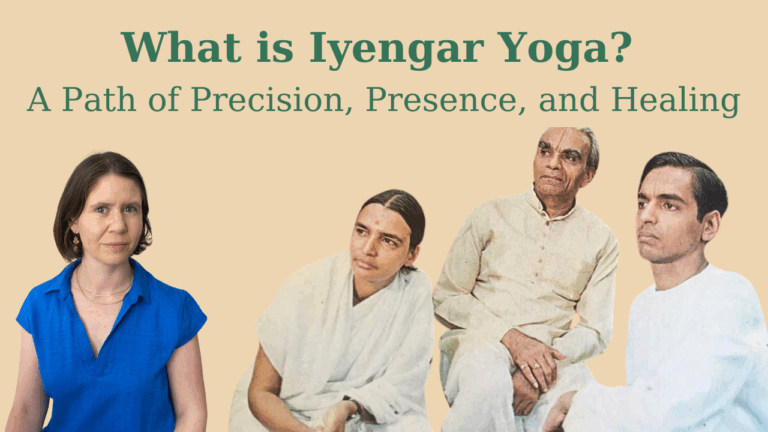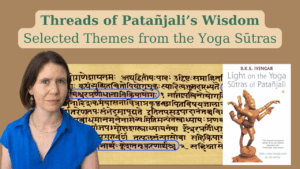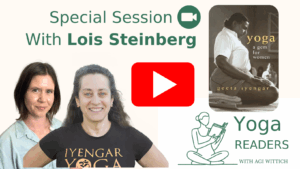
When I first encountered yoga, I, like many, was searching for something more than just physical exercise. What I found in Iyengar Yoga was not just a practice, but a profound methodology that resonated deeply with my own quest for understanding and well-being. Developed by the visionary Yogacharya B.K.S. Iyengar, this system became the very bedrock of my personal practice, my teaching philosophy, and ultimately, the subject of my doctoral research. It’s a path that, through its meticulous precision, has illuminated the intricate connection between body, mind, and spirit, leading me to a deeper appreciation of yoga’s therapeutic power, especially in the context of trauma recovery. For me, Iyengar Yoga is a living tradition that invites rigorous inquiry and profound self-discovery. Let me share why this method has been so transformative in my life and practice.
Guruji B.K.S. Iyengar
The foundation of this profound system lies with one extraordinary individual: Yogacharya B.K.S. Iyengar. Born in 1918 in a small village in India, he overcame severe childhood illness through the dedicated practice of yoga. This personal journey of healing fueled a lifelong devotion to understanding the intricate workings of the human body and mind.
Guruji, as he was affectionately known, was a true pioneer. He spent decades in relentless experimentation, observing, analyzing, and refining every single posture and breathing technique. His approach was akin to a scientific inquiry, meticulously documenting the effects of each movement and adjustment. It was through this rigorous, almost obsessive, dedication that he codified the principles of alignment and developed the innovative use of props that are now synonymous with his name. His seminal work, Light on Yoga, remains a cornerstone of yoga literature, a testament to his unparalleled depth of knowledge. Guruji’s unwavering commitment to clarity, precision, and accessibility transformed how yoga was understood and practiced globally, making it a powerful tool for health and spiritual growth for millions. My own path, and indeed the entire field of modern yoga, owes an immeasurable debt to his visionary work and tireless dedication.
The Legacy Continues: Geeta, Prashant, Abhijata, and RIMYI
The brilliance of B.K.S. Iyengar’s work didn’t end with him. He cultivated a lineage of exceptional teachers, most notably his own family, who have continued to deepen and expand the understanding of Iyengar Yoga.
Geeta S. Iyengar (1944-2018), his eldest daughter, was a formidable force in the yoga world. Affectionately known as “Mother” by her students, she was a dedicated practitioner, teacher, and scholar in her own right. Her work focused significantly on yoga for women, addressing the unique physiological and emotional needs throughout a woman’s life. Her book, Yoga: A Gem for Women, remains a classic in this field. Geeta-ji’s profound understanding of the subtleties of asana and pranayama, combined with her compassionate and insightful teaching style, made her an inspiration to countless practitioners worldwide.
Prashant S. Iyengar, B.K.S. Iyengar’s son, is known for his deep exploration of the philosophical and spiritual dimensions of yoga. His teachings delve into the intricate relationship between asana, pranayama, and the inner workings of the mind. He is renowned for his insightful discourses on Patanjali’s Yoga Sutras and other classical texts, bringing a unique intellectual rigor and spiritual depth to the practice.
Abhijata Sridhar, B.K.S. Iyengar’s granddaughter, represents the next generation of Iyengar Yoga masters. Trained from a young age by her grandfather, she embodies the precision and dedication that define the Iyengar method. As a teacher, she is known for her clarity, her dynamic energy, and her ability to connect with students of all levels. She carries the torch of the Iyengar tradition with grace and unwavering commitment.
RIMYI (Ramamani Iyengar Memorial Yoga Institute), located in Pune, India, is the heart and soul of the Iyengar Yoga world. Founded by B.K.S. Iyengar in memory of his wife, it is the mecca for serious students and teachers. RIMYI is not just a yoga school; it’s a center for learning, research, and the ongoing evolution of the Iyengar method. It is here that the rigorous training of Iyengar teachers takes place, ensuring the purity and integrity of the tradition are maintained. To study at RIMYI is to immerse oneself in the source of Iyengar Yoga, to be surrounded by its history, its wisdom, and its living spirit.
The Foundations That Guide My Practice
The genius of Iyengar Yoga lies in its fundamental principles, which, though seemingly simple, unlock layers of understanding about our own anatomy and consciousness. These are the hallmarks I cherish and teach.
In Iyengar Yoga, we often talk about alignment, and for good reason. It’s about more than just getting into a pose; it’s about how you arrive there, how each part of your body intelligently connects. For me, this has always felt like a profound conversation with my own body, teaching me to listen intently to its feedback. My academic work has consistently shown how this precise approach, grounded in anatomical understanding, not only builds strength and flexibility safely but also cultivates a heightened sense of proprioception—your body’s innate awareness of itself in space. This meticulous engagement becomes a powerful tool for self-observation, fostering a connection that goes beyond superficial movement.
One of the most distinctive features of Iyengar Yoga is the thoughtful use of props—blocks, belts, blankets, bolsters, and chairs. When I first encountered them, I saw them as aids, but through years of practice and teaching, I’ve come to understand them as sophisticated pedagogical partners. They democratize access, making even complex poses available to every body, regardless of age, physical condition, or perceived limitations. This inclusivity has always been deeply important to me. Props don’t just support; they teach. They allow you to feel the correct muscular and skeletal actions in a pose, deepening your understanding and reinforcing proper alignment. In my own work, especially with students navigating physical challenges or past traumas, props become invaluable for creating safe, supportive, and contained spaces within the practice. They allow for a deeply individualized approach, ensuring the pose serves the student’s specific needs.
In an Iyengar Yoga class, the order of poses is never arbitrary. Each class is built with intelligent sequencing—a carefully constructed narrative that prepares the body and mind, progressively unveiling the subtle layers of the practice. As I explored in my doctoral research on the global manifestations of this tradition, this methodical approach fosters a sense of trust and predictability within the practice. It ensures a balanced development of the body, gradually increasing capacity while always honoring the body’s readiness, making the journey both safe and profoundly effective.
A hallmark of Iyengar Yoga is the practice of holding poses for longer durations. For me, this has always been a powerful invitation to cultivate inner stillness and observation. It’s in these sustained moments that the true work begins: you have the opportunity to engage deeply with the pose, allowing its effects to permeate your physical and subtle bodies; you learn to observe the subtle shifts in your breath and mind, cultivating an unwavering presence that transcends mere physical exertion. This cultivation of inner quietude is incredibly regulating for the nervous system, providing a deep sense of calm and resilience that carries far beyond the mat.
Weaving Healing into Practice: My Trauma-Informed Approach
My academic background and extensive experience as a yoga therapist have led me to explore the profound synergy between Iyengar Yoga and trauma-informed practices. It’s a field I’m deeply passionate about, as I’ve witnessed how the precise, methodical, and empowering nature of Iyengar Yoga can be uniquely beneficial for individuals seeking to heal from traumatic experiences.
In my work, I emphasize how the Iyengar method provides a framework for agency and choice. The clear instructions and the option to modify extensively with props empower you to modulate your practice according to your needs, fostering a profound sense of control. This is especially critical for those who may have experienced situations where their agency was compromised. The focus on alignment and strong foundations offers tangible pathways for regulating a dysregulated nervous system, helping to bring a sense of safety and grounding back to the body. Crucially, I focus on guiding you to gently and safely reconnect with your body, fostering interoceptive awareness (the ability to feel internal sensations) in a way that feels supportive and non-overwhelming. This careful approach helps to rebuild trust and a harmonious relationship with your own physical self.
Deepening Your Understanding: The Wisdom of the Iyengar Texts
One of the greatest gifts of the Iyengar tradition is the vast body of written work left by B.K.S. Iyengar and his equally brilliant daughter, Geeta S. Iyengar. Their books, such as the monumental Light on Yoga, are not just guides to poses; they are profound philosophical treatises, practical wisdom, and spiritual insights born from decades of intense practice and study.
This is why I initiated “Yoga Readers”—a personal passion project where we delve into these foundational texts. Engaging with these writings is, for me, another essential dimension of practice. It allows us to connect directly to the lineage, learning from the original source and understanding the depth and breadth of their wisdom. It also encourages us to unpack philosophical concepts, exploring the ancient yogic philosophy that underpins the physical practice, enriching our understanding of ourselves and the world. Ultimately, it fosters intellectual inquiry, providing a space for curious minds to come together, discuss, and deepen their knowledge, moving beyond the physical into the rich intellectual landscape of yoga.
Your Invitation to Explore with Me
Whether you are seeking physical strength, mental clarity, emotional regulation, or a deeper philosophical understanding, Iyengar Yoga offers a rich and rewarding path. It’s a practice that truly meets you where you are, inviting you into a journey of profound self-discovery.
I invite you to explore the diverse resources I’ve curated here. Each piece is an extension of my passion and research, designed to support your yoga journey. Dive into philosophy by exploring my posts on Buddhi and the Pañca Kośas to understand core yogic concepts, and learn more about our Yoga Readers discussions. Watch my lectures for broader insights into the practice and its applications. Discover healing in my specialized articles on trauma-informed yoga, including my work on “The Imperative of Safe Spaces in Trauma-Informed Yoga.” And for practical tools, download guides like my “Sanskrit Pronunciation Guide for Common Yoga Terms” to enhance your practice.
Join me on this journey of embodied inquiry and continuous learning. What aspect of Iyengar Yoga are you most curious to explore first?
Ready to dive deeper? Explore my free offerings:
Curious about the deeper meaning behind the poses? Read my posts on Understanding Yogic Philosophy, and join my Yoga Readers onlie community.
Watch my lectures for a broader perspective on Yoga, its applications, and its profound wisdom.
If you are curious about Yoga for Well-being & Therapeutic Applications read about how Iyengar Yoga supports healing in my informative articles.
Get practical tools like my “Sanskrit Pronunciation Guide for Common Yoga Terms” to enhance your practice.
Your journey towards steadiness, ease, and profound self-awareness begins here.

A course of selected themes from the Yoga Sutras with Dr. Agi Wittich The Yoga Sūtras of Patañjali are the philosophical heart of yoga.

In a recent Yoga Readers session, Dr. Lois Steinberg opened her teaching archives and personal memories, sharing stories that span four decades of study
Agi Wittich is a yoga practitioner since two decades, and is a certified Iyengar Yoga teacher. Wittich studied Sanskrit and Tamil at the Hebrew University of Jerusalem, Israel, completing a PhD with a focus on Hinduism, Yoga, and Gender. She has published academic papers exploring topics such as Iyengar yoga and women, the effects of Western media on the image of yoga, and an analysis of the Thirumanthiram yoga text.